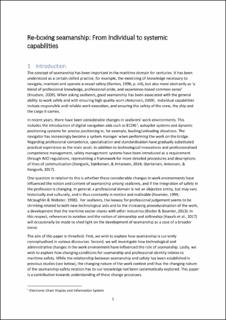| dc.contributor.author | Kongsvik, Trond | |
| dc.contributor.author | Haavik, Torgeir Kolstø | |
| dc.contributor.author | Bye, Rolf Johan | |
| dc.contributor.author | Almklov, Petter Grytten | |
| dc.date.accessioned | 2020-08-28T08:09:19Z | |
| dc.date.available | 2020-08-28T08:09:19Z | |
| dc.date.created | 2020-06-16T08:55:57Z | |
| dc.date.issued | 2020 | |
| dc.identifier.citation | Safety Science. 2020, 130 . | |
| dc.identifier.issn | 0925-7535 | |
| dc.identifier.uri | https://hdl.handle.net/11250/2675453 | |
| dc.description.abstract | Seamanship has been associated with certain individual skills and special knowledge related to navigation, operation and safety of sea-going vessels, but also to expected work ethics and obligations to fellow seamen. The term is also used in international shipping regulations, including the ability to make sound judgements. This paper explores how technological and administrative changes in the seafarers work environment influence on their understanding of seamanship and maritime safety. The qualitative design involved interviews of 15 seafarers on two offshore service vessels, in addition to observations of their work. The analysis indicated that the traditional concept of seamanship was challenged by the technology development in the industry, an ongoing proceduralization of their work, and the way new seafarers were trained and educated. Professional competence related to safety was perceived as being marginalized as a result of these developments. Distributed maritime capabilites is coined as a concept, involving a development where knowledge and competence is increasingly distributed to technology, procedures and regulations, thus profoundly changing the role of the individual seafarer. Some negative aspects of this development are addressed, although the ‘net’ effects need to be further explored. | |
| dc.language.iso | eng | |
| dc.relation.uri | https://www.sciencedirect.com/science/article/pii/S092575352030268X | |
| dc.title | Re-boxing seamanship: From individual to systemic capabilities | |
| dc.type | Peer reviewed | |
| dc.type | Journal article | |
| dc.description.version | acceptedVersion | |
| dc.source.pagenumber | 10 | |
| dc.source.volume | 130 | |
| dc.source.journal | Safety Science | |
| dc.identifier.doi | 10.1016/j.ssci.2020.104871 | |
| dc.identifier.cristin | 1815652 | |
| dc.relation.project | Norges forskningsråd: 236633 | |
| cristin.ispublished | true | |
| cristin.fulltext | postprint | |
| cristin.qualitycode | 2 | |
